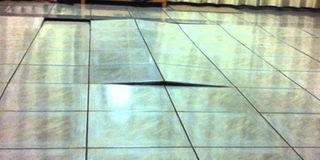Prime
Why your tiles are popping out

Farouk Oti was overjoyed when he finally moved his family into their own home in the quiet Seguku suburb. However, his joy was short-lived as Oti started noticing that tiles in his sitting room started shaking and finally “popped” out.
“I suspected that the maid’s style of mopping was to blame. My wife started supervising the maid to ensure she mopped properly,” explains Oti.
However, after a while tiles from other rooms in the house started shaking, loosening and coming out. Three months after moving into his new home, Oti was forced to re-tile the whole house.
Adhesive quality, amount
Boaz Kukundakwe, an architect with Abacus Technologies in Nakawa, says inferior installation methods such as using poor quality or incorrect adhesive can affect the longevity of tiles. He explains: “Tiles are placed using specific adhesive and bonding agents because they have varying properties for example water absorption levels.”
Not applying the right amount of adhesive is a major factor in tiles becoming loose. In trying to save cost of construction, the tile setter applies small patches of glue to the tile rather than an even coating. This leaves hollow voids, which when exposed to everyday traffic can cause stress to the tile and eventually lead to the tile coming loose.
Siraji Kazibwe, the marketing manager at Durapro, the manufacturers of quickset adhesives, says: “Quickset adhesive should be used when laying marble or granite tiles. Heavy duty should be used for porcelain tiles because it has a high bonding capacity that will match their high water absorption level and normal adhesive for ceramic tiles,” explains Kazibwe.
Tiles also buckle prematurely due to the use of adhesive for grouting, surplus adhesive not being removed from between tiles during installation and not allowing for expansion or movement around the perimetre of a tiled area.
Workmanship
Sloppy workmanship such as not cleaning the floor properly before installation of tiles means that the bonding layer will not be uniform, leaving room for moisture absorption which consequently damages the tiles.
Weather
Weather elements such as direct exposure to sunlight or rain will also eventually cause stress to the tiles because the glue and the foundation underneath consequently loosen them.
Exerted weight
Too much pressure will also cause tiles to buckle. “Every tile in your home is designed to withstand a certain weight. If that weight is exceeded often enough, it will cause the tile to break free of the grout and glue. Tiles in kitchens and bathrooms with heavy objects such as refrigerators and bathtubs placed on them can quickly come away from their foundation,” explains Dolores Mukisa Makholo, a design architect.
Tiles in heavy traffic areas such as hallways or kitchens can also over time start to loosen as more pressure is applied to them. This process is hastened when the tile is incorrectly installed.
At the end of the day, remember that tiles are permeable and will eventually swell with high moisture absorption and come loose. However, other factors such as workmanship, the type of product you are using, and the surface you are tiling determine how long it will take for this to happen. If all considerations had been taken into account, including the irreversible moisture expansion of the tile mentioned, then there should be no reason why the tiles would lift prematurely.
Prevention tips
Use mats at entrances to trap moisture and grit which otherwise can damage and prematurely wear the surface.
Avoid latex or rubber back mats as they can cause discoloration.
Wipe up spills promptly, using absorbent cloth or paper towel.
Do not clean your floor with bleach as it may cause discolouration of grout or accelerate grout breakdown.




